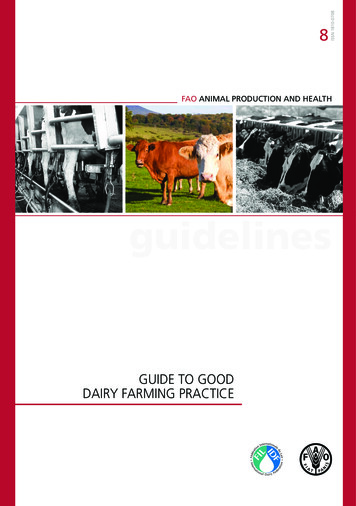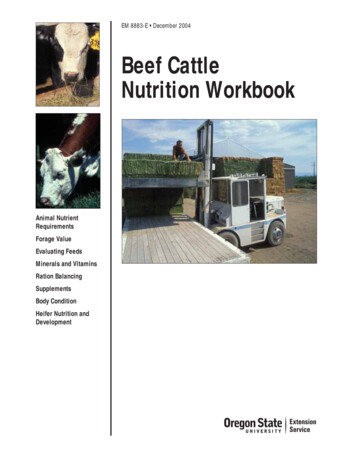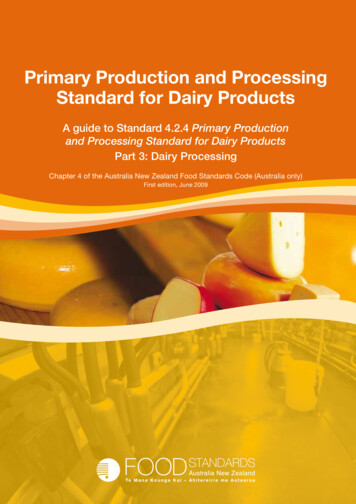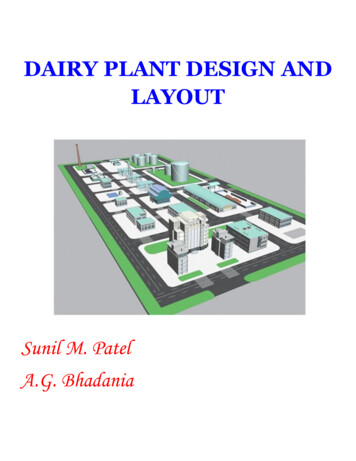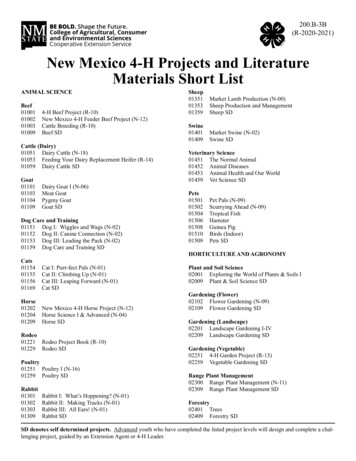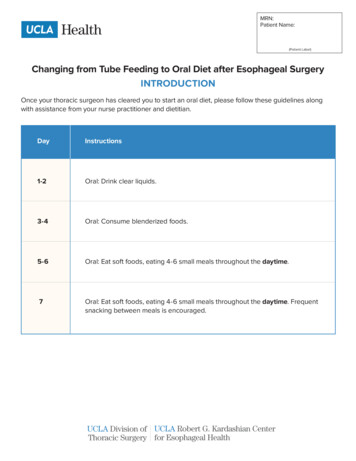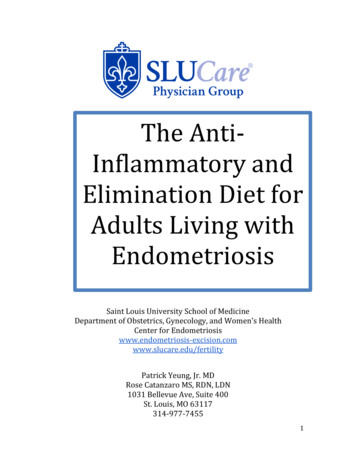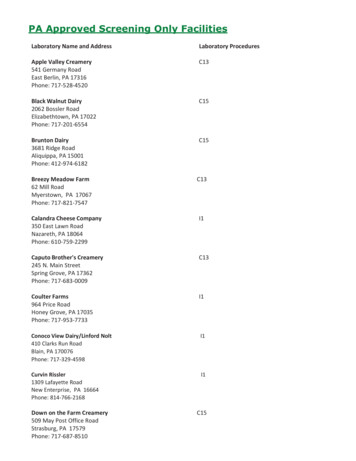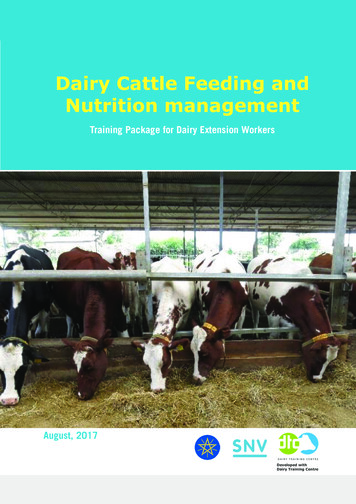
Transcription
Dairy Cattle Feeding andNutrition managementTraining Package for Dairy Extension WorkersAugust, 2017Developed withDairy Training Centre
Dairy Cattle Feeding andNutrition managementPart I Training manualPart II Training Guideline2
PrefaceSNV Ethiopia, through EDGET project (Enhancing Dairy Sector Growth in Ethiopia, 20132018), engages in the capacity building, extension services and innovative support to theEthiopian dairy sector particularly working with smallholder dairy farmers. The aim of theproject is to increase milk production and productivity in order to double the income of thesmallholder dairy farmers. EDGET is operational in the regions Oromia, Amhara and SNNP,and working with 65,000 dairy farming households.The project works closely together with livestock regional bureaus and their respectivezonal, woreda and kebele staff in delivering extension and other supports. One area ofcollaboration is the development of practical training and coaching tools and materials forextension workers based on a need assessment.SNV has engaged the Netherlands based Dairy Training Centre (DTC) for the developmentof the Training package for extension workers. The documents were more elaborated andvalidated with the utmost contribution of high level experts from regional Livestock andFisheries resources Development Bureaus/Agencies and Research Centers from the threeoperational regions of EDGET.Overall nine training packages were developed on Breed Improvement and FertilityManagement; Dairy Cattle Feeding and Nutrition Management; Dairy Cattle HealthManagement; Dairy Farm Management; Dairy Housing and Manure Management; FarmEconomics; Forage Production and Management; Hygienic and Quality Milk Production;Young Stock Management.This training package is on Dairy Cattle Feeding and Nutrition Management.SNV, also on behalf of the experts that contributed and DTC, would hope to see the materialswidely used outside the project areas by all interested dairy development practitioners.The materials will be available in hard copies and soft copies including on SNV websitewww.snvworld.org and other relevant websites.I
Table of ContentsPreface . IList of tables . IVList of Figures . VAbbreviations . VII. Dairy Cattle Feeding and Nutrition Management Training manual . 11. Introduction . 12. Dairy Cow Behavior and Impact on Dairy Cattle Nutrition Management . 12.1 Dairy Cow Behavior . 12.2 Impact of behavior on Feeding Management . 23.The digestive system of ruminants . 33.1 The foregut of the ruminant . 33.2 Digestion of carbohydrates, protein and fat in the fore stomachs . 54.The composition of feedstuffs . 84.1 Water and dry matter . 84.2 Carbohydrates . 84.3 Fats . 94.4 Crude protein . 94.5 Inorganic matter or “ash” . 94.6 Summary of the composition of feedstuffs . 105.Determination of the feeding value of feedstuffs . 105.1 Methods used to analyze the feeding value of feedstuffs . 105.2 The utilization of energy by a ruminant animal . 115.3 Energy evaluation systems . 125.4 Protein evaluation systems . 126. Feed resources in Ethiopia and their characteristics . 136.1 Roughages . 136.2 Concentrates . 156.3 Comparing the quality of roughages and concentrates on dry matter basis . 167. Feed requirements for various categories of dairy animals .177.1 Energy and protein requirement for maintenance and lactation . 177.2 Feeding of dry and pregnant animals . 187.3 Feeding of milking cows in different stages of lactation . 207.3.1 Feeding of a cow during early lactation . 207.3.2 Feeding of a cow during mid and late lactation . 217.4 Mineral and vitamin requirements . 227.4.1 Which minerals are needed? . 227.4.2 Mineral requirements of dairy cattle . 237.4.3 General remarks regarding mineral supplementation . 247.4.4 Vitamins . 247.5 Water requirements . 247.6. Feeding guidelines for dairy crossbred cows . 25II
8. Feed Improvement and feed storage . 288.1 Urea-molasses straw treatment . 288.2 Multi-nutrient block preparation . 288.3 Feed storage . 308.3.1 Causes of feed spoilage and losses . 308.3.2 Proper feed handling and storage . 329. Ration calculation . 329.1 Dry matter intake . 329.2 Steps to be taken in calculating and balancing a ration . 349.3 Supplementation and substitution . 359.4 Formulation of concentrate mixtures on the farm . 3610. Planning for dry season feeding . 3911. Monitoring Dairy Cattle Nutrition Management . 39References . 41Annex 1: List of common feedstuffs in the (sub) tropics and their nutritive value forcattle . 42II. Dairy Cattle Feeding and Nutrition management Training Guideline . 47A. Module Book .48B. Lesson matrix . 53C. Checklist for monitoring feeding management . 61D. Judgement results last milk production registration . 63E. Analysis of possible metabolic disorders . 64III
List of tablesTable 1:Maintenance requirements of adult cows per day . 17Table 2: Production requirements per kg of milk . 18Table 3: Maintenance and pregnancy requirements per day . 20Table 4: Function and deficiency signs of macro and micro elements . 22Table 5: Mineral requirements of dairy cattle . 24Table 6: Requirements for preparing urea treatment of straw . 28Table 7: Materials required for multi-nutrient block preparation . 29Table 8: Criteria dairy cattle nutrition management . 39IV
List of FiguresFigure 1: Enough feed and feeding space ensures a high feed intake . 3Figure 2: Schematic representation of ruminant’s digestive system . 3Figure 3: Rumen Papillae . 4Figure 4: Schematic representation of the fore stomachs . 4Figure 5: Damaged rumen papillae due to rumen acidosis . 6Figure 6: Composition of feedstuff . 10Figure 7: Naivasha Star grass pasture . 14Figure 8: Maize silage . 14Figure 9: Young, dark green (well fertilized) leafy Napier . 15Figure 10: Examples of multi-nutrient blocks . 30Figure 11: Three bags of napier (60 kg) is enough to feed 1 crossbread cow for 1 day . 33Figure 12: Concentrate supplementation during milking, maximum 2-3 kg . 35V
AbbreviationsADFAcid Detergent FiberBCSBody Condition ScoringCFCrude FiberCPCrude ProteinDCPDigestible Crude ProteinDMDry MatterEEEther ExtractIOMInorganic MatterNDFNeutral Detergent FiberNFCNon Fiber CarbohydratesNFENitrogen Free ExtractNPNNon-Protein NitrogenNRCNational Research CouncilOMOrganic MatterTDNTotal Digestible NutrientsVI
I. Dairy Cattle Feeding and Nutrition Management Training manual1. IntroductionOver the last decades an enormous amount of research has been done into the waysin which livestock use feed to maintain life, to grow, to reproduce and to produce all ofthe animal products which man uses, especially milk.In Ethiopia animal production is often a secondary activity within the subsistencefarming system. However, commercial dairy farming in Ethiopia is expanding due toincome increase, rapid urbanization and changing dietary habits.Dairy cows (and all other ruminants) have the capacity to convert roughages andother by- products from the human food industry, otherwise useless waste products,into valuable products like milk and meat. In this capacity as “waste product utilizers”ruminants contribute to the environment. However also negative impact from managinglivestock is there. In Ethiopia overgrazing has caused land erosion and in 2007 the FAOcalculated that the livestock sector contributes 18 % of all greenhouse gas emissionswhich lead to climate change.Another aspect is the cost of feeding. In virtually all commercial livestock farmingsystems the purchase of feed and/or the cost of growing fodder is the most expensiveitem of the production costs. Because of these high costs it is therefore very importantthat feedstuffs are utilized in the most optimal way. To do so it is very important thatone has excellent knowledge and skills with regard to feeding management.In some cases, due to the “green revolution”, farmers are able to produce more andbetter quality feed and fodder. However, due to the absence of proper skills in feedingmanagement, the extra feed and fodder resources are not utilized in the best way.Farmers always have to work against limitations which are usually not of their ownmaking or choosing. For example shortages of land, shortages of high quality feedstuffsto offset an abundance of poor quality roughages, climate change, etc. Each of thesesituations brings different, farmer specific, practical problems, but the nutritionalchallenge and dairy cattle nutrition management objective remains the same: Anattempt to produce a properly balanced diet at the least cost to the farmer withoutaffecting the environment giving the farmer the optimum income from his/her dairyenterprise.Although this manual will not provide the answer for each and every “specific situation”it does provide the (theoretical) knowledge and guiding principles to help farmers intheir feeding management.2. Dairy Cow Behavior and Impact on Dairy Cattle NutritionManagement2.1 Dairy Cow BehaviorDairy cows have evolved from originally ruminating prey animals. Rumination and thefermentation which takes place in the rumen allows dairy cows/ruminants to turn lowquality forages and human food by-products into high quality food: milk and meat.Ruminating prey animals forage in open plains with plenty of grazing grass and quickly1
return to hiding places in the bush/forest where they lie down at a comfortable and dryplace and ruminate protected from predators.They are social animals and always will graze, lie down and ruminate together. Thisbehavior is still present in the dairy cows today. Dairy cows also use eating and drinkingto confirm relationships and dominance in the herd. Dominant cows make it clear thatthey are the boss and cows lower in the hierarchy indicate that they know their placeat eating and drinking places. It is essential behavior which will be expressed.Prey animals always keep an eye on each other and their surroundings and reactimmediately to any threats, other animal’s reaction and unfamiliar situations. Anervous cow eats more quickly resulting in a lower feed intake. Cows will also standmore in such a situation instead of lying down. Nervousness can be caused by manythings such as conflicts with other cows, fear of people, not enough space to lie downor cubicles which are not comfortable (wet/dirty, incorrect dimensions, hard surface,etc.), not enough eating or drinking space causing dominant cows to chase away lowerranking animals, different feeding times (cows need “routine” !), etc.2.2 Impact of behavior on Feeding ManagementThe above explained natural behavior has the following implications on FeedingManagement: The feeding manger should be large enough to allow all cows to eat at the sametime! The feeding manger should have feed, preferably of the same quality, 24hours per day to avoid dominant cows to eat the best. Preferably feed mangersshould be 5-10 cm higher than the standing place of the cow (a position similarto the situation of grazing animals). In this position cows will produce more salivaduring feeding which improves rumen function. Make sure that the feed fence iscomfortable for cows to access, see also the Dairy housing and manure managementmanual. Feed cows always at the same time. Make sure that feed is easily accessible. Cowsneed/want routine. Feed enough so that the feeding manger will never be emptyand accept feed leftovers. Clean the feeding manger at least once a day (feedingmangers with a smooth easy to clean surface also leads to reduced heating up offeed). In this situation cows will eat in small portions throughout the day ensuringthat the rumen is always full and functioning well, see also chapter 3. Make sure that cows have access to clean and fresh water 24 hours per day. Cowsdrink 6 to 14 times per day. Usually after milking and after every meal. Preferredtemperature should be between 17 – 27 oC. Cows prefer to drink together from anopen low trough (50 cm). Make sure that at least 10 % of cows can drink at thesame time. Make sure that there are enough comfortable cubicles/lying down areas for thecows (cows should lie down at least 12 hours per day). They will spend 8 to 10hours ruminating. Treat cows gently (no shouting, no beating, etc.). Avoid stressful situations.2
Figure 1: Enough feed and feeding space ensures a high feed intake3. The digestive system of ruminants.3.1 The foregut of the nt components ofa feedstuff in such a waythat they can be taken upby the blood stream andtransported to the placesin the body where they areneeded. The process ofdigestion in non-ruminantsas well as in ruminants takesplace under the influenceof enzymes. Enzymes aresubstances which stimulateor facilitate certain chemicalprocesses.Figure 2: Schematic representation of ruminant’s digestivesystem3
The abomasum is comparable to the stomach of non-ruminants; the other stomachs(the so called fore-stomachs) are specific for the ruminant.Due to the relative large volume and specific action of the fore stomachs, the cow isable to take in quite a lot of bulky vegetable feed. Through breeding the exotic breeds(Holstein Frisian and the Jersey for example) have evolved into cattle breeds havingrelatively big digestive systems.A common descriptive term for the rumen is the fermentation vat, as it serves as areservoir of feed and supports an active microbial fermentation.Figure 3: Rumen PapillaeThe inside of the rumen wall is lined with papillae,small finger-like projections, which increase therumen’s absorptive area (see figure 3). Volatile fattyacids, ammonia and water move through the rumenwall directly to the blood stream. Increasing therumen available energy content of the diet (starch)will stimulate papillae growth. This in turn improvesrumen absorption of volatile fatty acids into the bloodstream. The number and size of rumen papillae ofcows not receiving concentrates (like dry cows) aretherefore less. Just after birth the fore stomachs ofthe calf are still not developed. The milk which thecalf drinks goes directly to the abomasum throughthe esophageal groove. However, the fore stomachsdevelop quite rapidly and at the age of 6 weeksthe volume of the fore stomachs is about the samesize of that of the abomasum. This development is(and should be) stimulated through the feeding ofroughage and especially concentrate.In adult Holstein Frisian cows the volume of the fore stomachs is about 15 times ofthat of the abomasum. The rumen has then a volume of 100 – 150 liters.The rumen content is made up of three layers. At the bottom is the liquid layer. On thislayer floats a solid mass of roughage particles and in the space above this layer gasseswill be present.Figure 4: Schematic representation of the fore stomachs.4
The rumen will have over two contractions per minute. This mixes the rumen contents,brings bacteria and feed into contact, moves material out of the rumen if it is denseand short, and brings long particles to the top surface for rumination to occur.The cow spends 8 -10 hours per day ruminating (chewing her cud). The rumination cycleconsists of four functions. Regurgitation occurs when an area around the esophagusis stimulated with coarse material (scratch effect of fibrous roughages). A handful ofcoarse material is regurgitated to the mouth by a reverse peristalsis movement.Once the coarse feed is in the mouth, the second phase (re-chewing) occurs, grindingthe feed to a smaller particle size which will allow it to pass out of the rumen.The third phase is re-salivation. Saliva contains buffers, which mixed with theregurgitated material will stabilize the rumen pH. A cow produces over a 150 liters ofsaliva every day when proper rumination occurs.The fourth phase is when the cow re-swallows the cud. If the coarse material hasbeen mechanically reduced through chewing, the material should sink in the rumenand moves to the reticulum. Feed leaves the rumen when the particle size is dense(heavy) and short. Long particles will float in the rumen, forming the forage or hayraft in the top of the rumen and stimulate additional rumination time. If material is toocoarse, such as straw, too much time is needed to re-chew the feed, and this reducesoverall dry matter intake. When feed is fermenting in the rumen large amounts ofmethane, carbon dioxide, and other gases are formed and must be expelled (from 30to 50 liters per hour). Methane and carbon dioxide are important greenhouse gases.Under normal conditions, distension from gases will stimulate the cow to have a rumencontraction which will clear the esophagus region and allow gas to be belched oreructated. If this area can’t be cleared or gas forms a froth, the cow may bloat. If theanimal takes liquid feed it will pass directly into the abomasum through the esophagealgroove. Digestion continues in the abomasum in the same way as with animals havingone stomach (non-ruminants).The above makes it clear that ruminants are able to digest feedstuffs which are notdigestible for animals having only one stomach. These feedstuffs are often wasteproducts from the production of food for human consumption and/or grown on landwhich is unsuitable for anything else but fodder crops/grass production. As suchruminants are essential in each farming system for optimum utilization of naturalresources and waste products and are therefore playing a very positive role in protectingthe environment. The greenhouse gas emissions however pose a threat. Increasingmilk production per cow is the shortest route to a reduction of these greenhouse gasesper liter of milk!3.2 Digestion of carbohydrates, protein and fat in the fore stomachs.The feed mixed with some saliva enters the fore stomachs. In the rumen the micro flora(billions of bacteria and protozoa) starts with the digestion process. What happens inthe fore stomachs during this process is the following:5
a)The breaking down of part of the carbohydrates, mainly into:·acetic acid, which is needed in the butter fat making process;especially cellulose contributes to the formation of acetic acid.·propionic acid, which provides energy to the animal andwhich is needed for the formation of milk sugar; especiallystarches and sugars in the feed contribute.·butyric acid.These volatile fatty acids are for thelargest part absorbed through therumen wall into the blood streamof the cow and transported to theliver, mammary gland, fatty tissuedeposits and other tissues. Thesevolatile fatty acids provide 60 – 80% of the energy requirements of thecow. Fat, carbohydrates not degradedin the rumen and protein provide theremaining energy. The remainingvolatile fatty acids produced in therumen are utilized by the microbes forthe production of microbial protein.Under special circumstances alsolactic acid can be produced in therumen. Since this acid is not volatile it Figure 5: Damaged rumen papillae due to rumencan play a negative role in the rumen acidosisfermentation, causing acidification ofthe rumen content and rumen acidosis. Rumen acidosis will cause damaging of rumenpapillae (see figure 5).b) The breaking down of part of the protein of the feed into amino acids. These aminoacids are either used in the formation of protein made by the micro flora in therumen or broken down still further into ammonia, carbon dioxide and volatile fattyacids.On average around 60 - 70 % of the dietary protein is transformed/ “digested” by therumen microbes in the rumen. The microbes in the rumen not only use the amino acidsfrom the feed, they are also able to make all necessary amino acids out of non-proteinnitrogen (NPN), for example out of ammonia. The non-ruminant animal does not havethis capability. The microbes in the rumen will only “produce” amino acids out of ureaif certain conditions are met:·There must be sufficient easily digestible carbohydrates available in the rumen tosupply the energy to the micro flora to “produce” amino acids.·There should be a clear shortage of “natural” protein in the feed.·The urea should be supplied in small quantities and at regular intervals.6
There is a limit to what the dairy cow (in fact her rumen) can “handle” in the form ofNPN. Under normal circumstances around 130 g of microbial protein is produced forevery 1000 g of digestible organic matter which enters the rumen! In order to achievethis level the rumen fluid should contain 150 g of ammonia per liter.c) Fat is present at modest levels in diets commonly fed to dairy cattle. Dietary fatand oil are consumed either as triglycerides (three fatty acids attached to a glycerolmolecule) or as free fatty acids.Rumen microbes hydrolyze triglycerides to fatty acids and glycerol (used by microbes asa minor energy source). The fatty acids can be classified as saturated and unsaturated.Rumen microbes partially hydrogenate unsaturated fatty acids, forming more saturatedfatty acids with similar carbon length. Fatty acids (such as those in soybeans or fishmeal) can interfere negatively with rumen fermentation and lower fiber digestibility.Unsaturated fatty acid can be toxic to fiber digesting bacteria and coat fiber particles,thereby reducing bacterial attachment and fiber digestion. Rumen inert fats do notaffect rumen fermentation. In general fat content in the ration should be limited to amaximum of 5% whereby feeding of fish oil should be minimal. Feed oil seeds whole orcoarsely processed to minimize exposing rumen microbes to high levels of unsaturatedfatty acids.Digestibility coefficient.Not all the feed an animal eats is digested. The part that is not digested will leavethe body as feces and is not used by the animal. The digested part of the feed canbe expressed as a percentage of the total feed intake. This percentage is called thedigestibility coefficient.Example :A cow eats 12 kg dry matter per day, of which 3 kg is later found in the feces.This means that 12 – 3 9 kg dry matter has been digested. The digestibilitycoefficient of the dry matter is then 9/12 x 100 75 %. In other words 75 % ofthe dry matter has been digested.Depending on the feedstuff the digestibility may vary a lot. Some products such asmost feeds of animal origin, young grass and other green forages are very easilydigested (high digestibility coefficient) while other products such as straw and chaffare difficult to digest (low digestibility coefficient).Other factors which might influence the digestibility of a feedstuff are:·The kind of animal (goat, sheep, cow; local or “exotic” breed, etc.)·The level of feeding (the more feed the animal consumes, the lower thedigestion will be)·The structure of the feed (“fine” feed is digested more easily than “coarse”feed; it is for example not sensible to feed whole grains to cattle).7
·The age of the animal; very young and very old animals digest the feedsomewhat less efficiently.·Maturity stage of the plant, early harvested and 50% blooming stage ismore digestible and nutritious than matured plants.·Physical composition of the plant, i.e. leaf to stem ratio of the feed4.The composition of feedstuffs.4.1 Water and dry matter.All feedstuffs consist of water and dry matter. For example if the water content ofa feedstuff is 75%, the dry matter (DM) content is 25 %. Although water is veryimportant for cattle, it plays a vital role in functioning of the body, milk production,and the total intake of food. A shortage or uneven supply of drinking water has adirect impact on the dry matter intake and milk production. It is the dry matter whichcontains the nutrients cattle need.4.2 Carbohydrates.Carbohydrates in feedstuffs comprise of sugars, starches (e.g. derived from cereals,tubers and roots) and substances which are part of the plant cell walls, vessels andwoody tissues, mainly hemi-cellulose, pectin, cellulose and lignin. Pectin is found inhigh levels in beet pulp, citrus pulp and legumes and is the most rapidly fermentedportion of the cell wall.Part of the carbohydrates in feedstuffs is called “crude fiber” (CF) and the rest “nonfiber carbohydrates” (NFC). The latter consists of sugars, starches and sugar likesubstances. Sugars and starches are much easier to digest than crude fiber by therumen microbes.In the animal body carbohydrates are mainly used to provide the energy covering thedirect needs of the animal. If more energy is provided than immediately needed, thesurplus is stored as body fat.Crude fiber is very important for rumination and for the proper functioning of therumen. The ration for cattle therefore should contain a good quantity of crude fiber.The minimum amount is considered 20%. Because the old system for determining theCF content (boiling of feed with dilute acid and alkali) is considered not so accurateother chemical tests are now also in use:·Acid detergent fiber (ADF). ADF consists of cellulose, lignin and lignified nitrogencomponents (also called heat damaged protein, or ADF-nitrogen).·Neutral detergent fiber (NDF) consists of ADF (cellulose and lignin) and hemicellulose). Another term for NDF is cell wall content. NDF represents the total fibercontent of the feed.·Effective NDF (eNDF). eNDF measures the physical form or length of the feed.Values for eNDF are determined by sieving feeds or using screens to separateforage particle size.8
4.3 Fats.Fat or “ether extract” also provide energy. In fact a certain amount of fat providesmuch more energy ( 3x) than the same amount of carbohydrates. Some vitamins(for instance A, D, E and K) are found in the fat fraction of a feedstuff.Roughages have a low fat conte
I. Dairy Cattle Feeding and Nutrition Management Training manual 1. Introduction Over the last decades an enormous amount of research has been done into the ways in which livestock use feed to maintain life, to grow, to reproduce and to produce al
